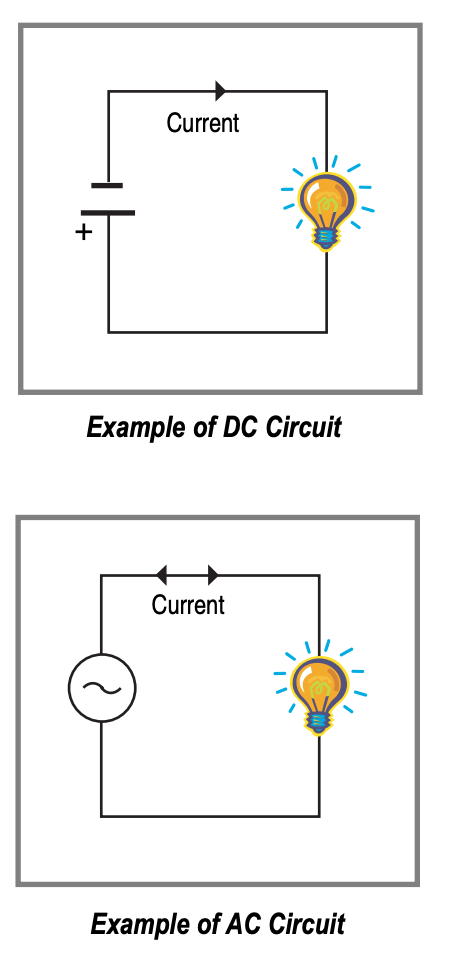 This application note is republished courtesy of Amprobe.
This application note is republished courtesy of Amprobe.
Regardless of popular belief, Power Quality is NOT difficult to understand. The problem is finding reliable sources of such information, provided in an easy-to-understand way with real-world examples. Many of the available sources are either “too technical” or are not complete. Easy-to-use devices and properly formatted information are crucial ingredients for a successful application. Let’s learn more…
What do I Need to Know About Power Quality?
Power quality can be generally described as the concept of powering and grounding sensitive equipment in a manner that is suitable to the operation of that equipment. (Source: Heydt, G.T. 1991. Electric power quality. West Lafayette, Indiana: Stars in a Circle Publications.) Well, this says a lot but without giving us any specifics. What we know for sure is that electrical equipment is powered either by AC or DC power sources. In the DC circuit, current flows in one direction. On the other hand, the AC power sources “pump” current “back and forth”.
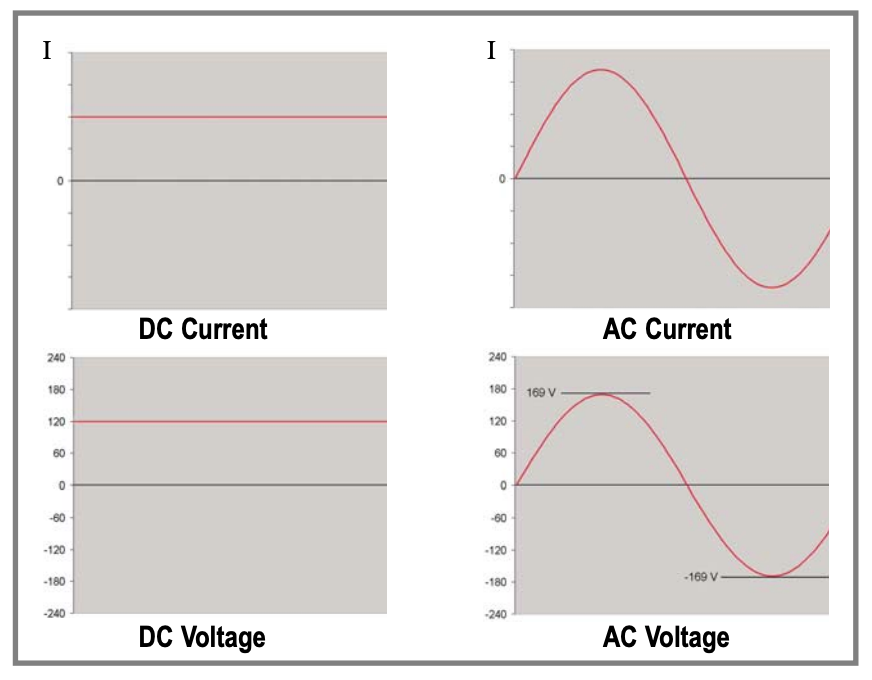 In the DC circuit, the voltage is equal to 120V. But the AC signal, on the right drawing, changes from 0 to 169V, then it drops to 0 and then it falls to negative –169V. And so on. So it is changing with time. But in reality when you are measuring AC voltage at the outlet in the residential building you expect to see 120V. How can it be if the value of the AC voltage is constantly changing with time?
In the DC circuit, the voltage is equal to 120V. But the AC signal, on the right drawing, changes from 0 to 169V, then it drops to 0 and then it falls to negative –169V. And so on. So it is changing with time. But in reality when you are measuring AC voltage at the outlet in the residential building you expect to see 120V. How can it be if the value of the AC voltage is constantly changing with time?
RMS Value of the Signal
To overcome this challenge, the RMS (Root Mean Square) formula is used to calculate the so-called effective value of AC voltage. Don’t panic. Amprobe meters are going to make this calculation for you. In the example above, a sinusoidal signal with a voltage peak of 169V will produce an RMS value of 120V. So… yes if the receptacle is powered by 120V RMS sine wave, its signal peak voltage is 169V! Keep in mind that the RMS is NOT the “Average”.
By definition, the RMS Value is equivalent to a DC voltage that would provide the same amount of heat generation in a resistor as the AC voltage would if applied to that same resistor.

And we would be done by now, but manufacturers of the test equipment took a little shortcut in their designs in the past. Here is what happened… The easiest and the least expensive way to design an AC meter is to have a circuit, measuring the average or peak value. Now, we know that the average value is not the same as RMS. But the RMS for the pure sine wave, remember ONLY if you have pure undistorted sine wave, can be easily calculated by multiplying the Average reading by 1.11.
VRMS = 1.11 x VAVG (true for pure sinewaves only)
Therefore standard meters, also called “Average Sensing Meters”, will simply measure the average reading and then multiply it by an appropriate coefficient to display RMS value of the measurement. Easy? So what is the problem?
Distorted Sine Waves
The problem is that the above-mentioned coefficients apply only to pure sine waves. However, a majority of the loads today are “non-linear,” so pure sine waves are rare.
By definition, the “Non-Linear Loads” are devices that draw non-sinusoidal currents when a sinusoidal voltage is applied. Frequently these are devices that convert AC to DC.
Instead of analyzing the above definition, I am going to list below some of the typical examples of non-linear loads:
- Electronics (radios, VCRs, computers, TV sets, etc…)
- Light dimmers
- Variable Frequency Drives (VFDs)
- 6-pulse Converters
- Power Rectifiers (e.g., plating systems)
- Uninterruptible Power Supplies (UPSs)
- Fluorescent and energy-saving lights
- DC Servo Drives (Robots)
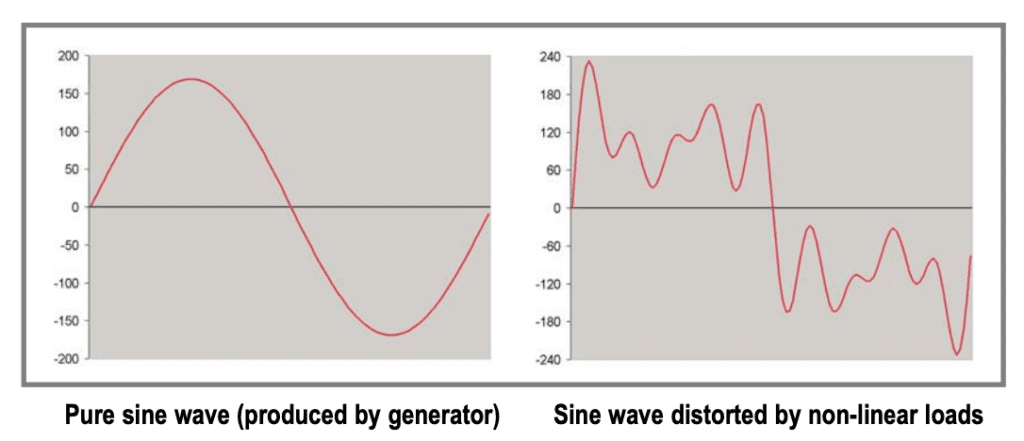 Depending on the distortion of the sine wave, the relation between the average value and the RMS value varies. Do you remember when we said that typical average sensing meters measure average value and then multiply this value by 1.11? This calculation holds ONLY for undistorted sine waves! It DOES NOT apply to distorted sine waves.
Depending on the distortion of the sine wave, the relation between the average value and the RMS value varies. Do you remember when we said that typical average sensing meters measure average value and then multiply this value by 1.11? This calculation holds ONLY for undistorted sine waves! It DOES NOT apply to distorted sine waves.
If we use a standard average sensing meter on a distorted sine wave, the measuring error can reach over 30% (usually these meters tend to measure lower). So instead of displaying 120V at the receptacle, you may read as low as 90V! This is a huge measuring error!
True RMS Reading (TRMS)
A True RMS (TRMS) meter uses a complex RMS converter to read the true RMS (heating) value for any type of AC waveform. In today’s sophisticated world, you can no longer count on pure sine waves. When the exact waveform is unknown, you should always use a TRMS instrument to measure an accurate value.
Sine Wave Distortion – Harmonics Distortion
Besides deceiving an average sensing meter, distortion of the voltage or current sine waves may cause other problems, such as:
- Failed Power Factor Correction Capacitors
- Blown Fuses (no apparent fault)
- Misfiring of AC and DC Drives
- Overheated Transformers
- Tripped Circuit Breakers
- Voltage Distortion
- Overheated Conductors
- High Neutral Currents
- High Neutral to Ground Voltages
- Increased System Losses (heat)
- Rotating and Electronic Equipment Failures
- Reduced Power Factor due to THD (total harmonic distortion)
In order to troubleshoot a system, we somehow need to connect a cause (the type of distortion) with the symptom (the resulting problem). For example, certain distortions cause transformers to overheat, others may reduce a power factor. So we should try to link the shape of the distorted sine wave, to the specific symptoms. But there is an infinite number of different shapes of distorted waves, so how can we make a reference to each of them?
To solve this puzzle we are going to use some help from… the music industry! In the 19th century, German scientist Hermann Helmholtz, was racking his brain to answer a theoretically very easy question: why do two different instruments playing the same note sound different?
Why do flutes and violins sound different? If the sound is a vibration of air molecules, and by playing the same note these instruments vibrate air molecules with the exact same frequency, why do they sound different? He discovered that musical instruments produce an entire array of sounds (many frequencies). But all of these sounds (frequencies) are multiples of the fundamental frequency. So if we use 60Hz as fundamental frequency, instruments will generate second harmonic (60Hz ∗ 2 = 120 Hz), third harmonic (60Hz ∗ 3 = 180Hz) and so on…
The combination of individual harmonics for each instrument varies, and that is a reason instruments playing the same note sound different.
Also in the 19th century, French mathematician, Jean Baptiste Joseph Fourier proved, in essence, any waveform could be decomposed or separated into sinusoids (sine waves) of different frequencies (harmonics). All these sine waves would sum up to the original waveform. The Fourier Transform identifies or distinguishes the different frequency sinusoids and their respective amplitudes.
In other words, no matter how distorted a sine wave is, it can be broken down into a fundamental frequency and individual harmonics. If you perform harmonic analysis with a power quality instrument, the distorted sine wave will be broken down into individual harmonics. Individual harmonics can then be linked to specific malfunctions in an electrical system. The harmonic analysis is performed separately for voltage and current, and for each phase of the three-phase system.
As a result of harmonic analysis, the instrument should measure and display the following information:
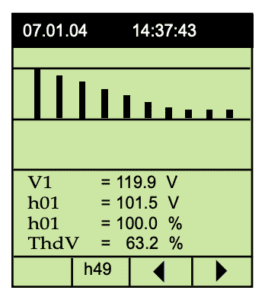 THD – This is Total Harmonic Distortion, a cumulative number, which represents the percentage of all harmonics in the signal. The more harmonics, the more distortion and more trouble you can expect.
THD – This is Total Harmonic Distortion, a cumulative number, which represents the percentage of all harmonics in the signal. The more harmonics, the more distortion and more trouble you can expect.
DC – This is the DC content of the signal. Generally the more DC content, the more problems can be expected.
Individual Harmonics – Knowing the percentage and/or amplitude of each harmonic, you can troubleshoot the system and prevent potentially damaging situations.
How to Diagnose a Harmonic Distortion Problem
When maintaining or troubleshooting electrical systems, you should always perform harmonic analysis. The IEEE Standard 519-1992 “IEEE Recommended Practices and Requirements for Harmonic Control in Electric Power Systems” has suggested limits on the number of harmonics that a customer or facility should produce. Below are some of the highlights:
- Power electric equipment is susceptible to misoperation caused by harmonic distortion.
- Computers and allied equipment such as programmable controllers frequently require AC sources that have no more than a 5% harmonic voltage distortion factor, with the largest single harmonic being no more than 3% of the fundamental voltage.
- Critical applications like hospitals and airports should have no more than 3% harmonic voltage distortion.
Harmonics Distortion Example
Let’s move to some real-world examples. In this three-phase four-wire system (WYE), each phase conducts a current of 100A. The system is balanced, so the neutral current should be zero, (three phase currents should cancel each other). You measure neutral and it reads 120A. Is this possible?
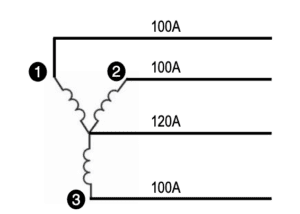 Well, when we performed harmonic analysis on this system, we noticed that the 3rd harmonic (60Hz ∗ 3 = 180Hz) on each leg contributed 40 Amps RMS. After research, we learned that in the 3 phase, 4 wire system, the 3rd harmonics add up on the neutral wire instead of canceling each other because they are in phase (see graphs below).
Well, when we performed harmonic analysis on this system, we noticed that the 3rd harmonic (60Hz ∗ 3 = 180Hz) on each leg contributed 40 Amps RMS. After research, we learned that in the 3 phase, 4 wire system, the 3rd harmonics add up on the neutral wire instead of canceling each other because they are in phase (see graphs below).
In our example, the currents are going to add up to 120A (40A + 40A + 40A). Always rely on a Power Quality or TRMS meter to measure neutral current, since it will read the combination of harmonics and system imbalance.
The odd multiples of the third harmonic (called “TRIPLENS”) are added together in the neutral and can cause overheating even with balanced loads.
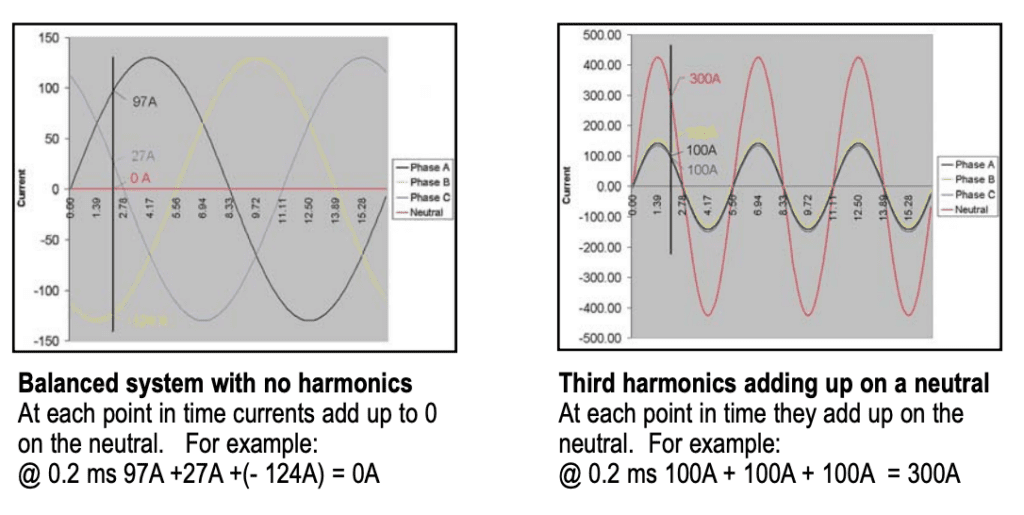 Solution
Solution
There are many companies producing specialized equipment to solve harmonic distortion problems. Contact them to find the best solution for the problem you are experiencing. One of the solutions for the problem we indicated above would be a filtering system, to mitigate a third harmonic.
All Faces of Power
Electric power makes the bulbs light, motors turn and your computer run. Electric power does many jobs. So what is it? What is the difference between Apparent, Reactive and Active Powers? What is a Power Factor? What are Watts, kilowatts, VARS, VA? Let us take a closer look…
TYPES OF POWER
Active or working power – is power, which performs useful work. This is the type of power we want to see. This power is measured in Watts [W].
Reactive Power – is simply power we are losing to produce the electromagnetic field in motor windings or to charge capacitors. It is wasted power, so we want to reduce it as much as possible! Reactive power is measured in Volt-Amps-Reactive [VAR].
Apparent Power – is a total (vector sum) of Active and Reactive powers. In other words, this is the total power that needs to be provided to cover useful, working power as well as wasted power. It is measured in VoltAmps [VA].
Peak Demand – If a power plant is not able to supply enough energy using their regular resources; they need to produce or deliver additional energy on demand. The cost of such energy is higher. The cost is calculated based on the maximum value of average power measured in 15 or 30 minutes intervals with a rate of 1 second, throughout 30 days time. The Demand is measured in Watts [W] or Volt-Amps [VA] depending on the energy provider.
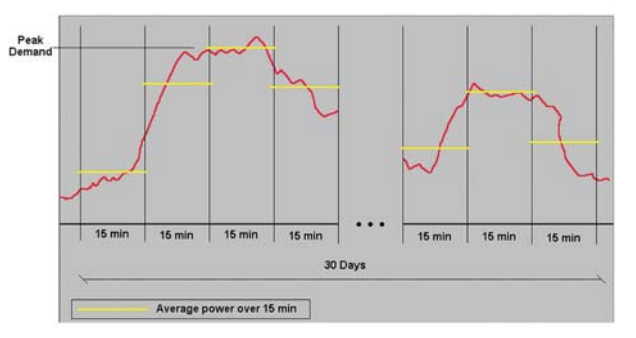 Power Factor – is a measure of how efficient a system is.
Power Factor – is a measure of how efficient a system is.
- Displacement Power Factor is related to the efficiency caused by phase shift between voltage and current
- True Power Factor describes the total efficiency of the system including total harmonic distortion and phase shift.
Power factor is measured from 0 to 1.
The lowest efficiency is 0 (0%) – meaning we lose all energy, and the highest is 1 (100% efficient system), meaning we use all produced energy.
A power factor of 0.5 describes a system that is 50% efficient.
A power factor of 0.95 describes a system that is 95% efficient. And so on. The bottom line is: the higher the power factor, the better!
Displacement Power Factor
Let’s see how we can make electrical systems more efficient and save on energy bills. To do so we need to learn how different types of loads affect our Power Factors.
The Resistive Loads
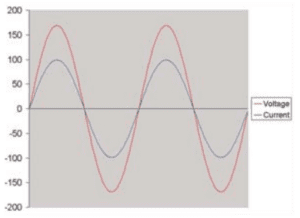 The “resistive” loads do not create a phase-shift. The voltage and current in above drawing are “in-phase”, meaning that they cross the X (time) axis in the same places. Such a system is very efficient, with a Displacement Power Factor of 1 (100% efficient) since there is no Reactive power present.
The “resistive” loads do not create a phase-shift. The voltage and current in above drawing are “in-phase”, meaning that they cross the X (time) axis in the same places. Such a system is very efficient, with a Displacement Power Factor of 1 (100% efficient) since there is no Reactive power present.
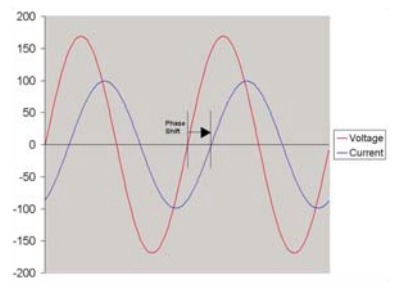 The inductive loads cause current to lag the voltage. Motors are good examples of such loads. Motors create Reactive power, which affects the power factor in a negative way. The more motors you connect to the system the more energy you are losing. Due to this very reason, the Displacement Power Factor can be as low as 0.6 (or even lower), meaning that only 60% of supplied energy is used and almost 40% is wasted! That also means that somebody is paying for this 40% wasted energy. Wouldn’t it be nice to save this money?
The inductive loads cause current to lag the voltage. Motors are good examples of such loads. Motors create Reactive power, which affects the power factor in a negative way. The more motors you connect to the system the more energy you are losing. Due to this very reason, the Displacement Power Factor can be as low as 0.6 (or even lower), meaning that only 60% of supplied energy is used and almost 40% is wasted! That also means that somebody is paying for this 40% wasted energy. Wouldn’t it be nice to save this money?
Here is the good news: Capacitive loads cause the current to lead the voltage.
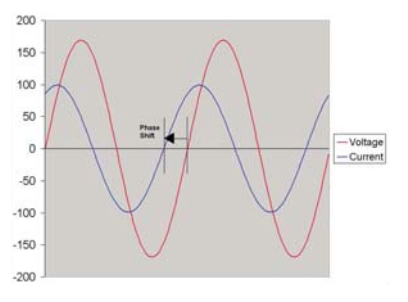 Compare the above drawings. Did you notice that capacitance (capacitor) shifts current in an opposite direction to inductance (motor coil)?
Compare the above drawings. Did you notice that capacitance (capacitor) shifts current in an opposite direction to inductance (motor coil)?
Displacement Power Factor (DPF) Correction
This means that the inductive “lagging” DPF produced by motor windings can be “balanced” with “leading” capacitance. So if we add capacitors to these systems, we will correct (shift) the DPF and bring it closer to 1 (100% effective system). This will reduce the electric bill. This technique is known as Power Factor correction.
TRUE Power Factor
True Power Factor consists of DPF and harmonic distortion. The harmonic distortion component is more difficult to correct since it requires removing harmonics from the system. This process usually requires specialized equipment like harmonic filters and K-rated transformers.
Energy
Energy is power used over time. Energy, like power, can be active, reactive or apparent.
Active Energy – is active power consumed over time. It is measured in Watt-hours [Wh]
Reactive Energy – is reactive power consumed over time. It is measured in Volt-Amp-Reactive hours [VARh].
Apparent Energy – is apparent power consumed over time. It is measured in Volt-Amp hours [VAh].
Mystery of Prefixes: Prefixes can be used with any physical value: Volts, Amps, Watts, VAR, etc… In test and measurement they are used to simplify readings. For example, instead of saying 0.000002A , I can say 2µA [micro Amps]. Instead of displaying 4,000,000,000Ω, we can display 4GΩ.
The table below explains the most often used prefixes. In order to convert units, simply multiply reading by ratio (see examples in the table):
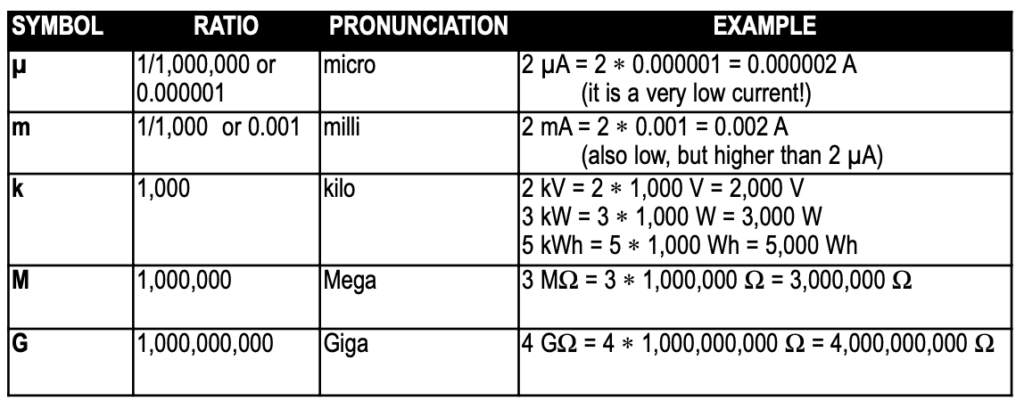
You probably have heard about kWatts [kilowatts] or kWh [kilowatt hours]. 1kW is 1000 W [watts] and 1kWh is 1000 Wh [watt hours].
ELECTRICAL SYMBOLS
A Amps or Amperage
AC Abbreviation for Alternating Current
COM Reference voltage input. On a three-phase four-wire system it is connected to a neutral wire.
dB Decibels – Used in communication to indicate Volume. It is not a linear relationship, i.e. as dB increases the apparent volume increases more quickly.
dBm Measure of absolute power. Used in communication work. Zero dBm equals one milliwatt.
DC Abbreviation for Direct Current
DPF Displacement power factor
Hz Hertz or frequency – Formerly called cycles, as in 60 cycles. Frequency is expressed as the number of cycles per second, usually 60 Hz in the U.S., 50 Hz in Europe.
I Electrical current measured in Amps. I1, I2, I3 or (IA, IB, IC) respectively indicate current in phases 1, 2, and 3. IN indicated current in a neutral wire.
kW 1,000 wafts – the common measure of Power.
kWh kilowatt Hour – 1,000 watt hours. The measure of energy used.
P Active or Working Power
PF Power Factor
Q Reactive Power
S Apparent Power
TPF True Power Factor
V Volts or Voltage, V1, V2, V3 (or VA, VB, VC) respectively indicate phases 1, 2, and 3.
Some Other Electrical Terms:
Auto Ranging – Instrument automatically selects the best range for measurement being made.
Capacitance – A capacitor is an electronic component that temporarily stores energy and resists a sudden change in circuit voltage. Its value (capacitance) is usually stated in microfarads.
Crest – Peak or topmost part of a waveform from the zero reference.
Crest Factor – Ratio of the peak to TRMS value of a waveform.
Continuity – An electrical test to determine if a continuous path for the flow of current is established.
Counts – The maximum number (counts) a digital instrument can display (a 1999 display is 2000 counts).
Diode Test – Instrument can test the forward and reverse conduction conditions of a diode.
Duty Cycle – The ratio of Time On vs. Time Off of a machine or waveform.
Harmonic Distortion – In the early 1980’s, a new efficient power supply called a “switch mode power supply” began showing up in electronic products. This supply converts the incoming sine wave to a distorted waveform. If a device converts AC to DC or vice versa (via a switch mode power supply) as part of its routine operation, it is a harmonic generating device. Such devices include copiers, computers, UPS systems and many more common everyday devices.
Harmonics – Voltages or currents that are at a multiple of the fundamental frequency. In the US, the fundamental frequency is 60 Hz.; therefore, harmonics can occur at 120 Hz, 180 Hz, 240 Hz and so on. Harmonics are usually specified by their numeric order. For example, the third harmonic is 180 Hz (60×3).
Hold – The ability of a digital instrument to retain (Hold) its Last Reading after connections to the circuit are removed.
Inductance – An inductor is an electrical component that resists a sudden change in electric current. Its value (inductance) is typically stated in millihenries.
Input Impedance – The loading (impedance), in ohms, an instrument presents to the circuit being tested. (This is typically 10 Meg-ohms for digital multimeters).
Peak – The absolute maximum (crest) excursion of a measured waveform from the zero reference.
Polarity – The ability of a digital instrument to display polarity to determine the direction of current flow.
Power Factor – Ratio of Actual Power to the Apparent Power.
Range – A measurement span (i.e.: 0-200 is range of measurement).
RS-232 – An EIA-defined standard permitting serial communications between computer terminals, modems, instruments, etc.
Sag (Valley) – A sudden DECREASE in the amplitude of the nominal electrical value. This disturbance lasts for 1/2 cycle or longer.
Spike (Noise) – An abrupt transient of less than one millisecond which comprises parts of a waveform and may considerably exceed its average amplitude.
Surge (Swell) – A sudden INCREASE in the amplitude of the nominal electrical value. This disturbance lasts for 1/2 cycle or longer.
True RMS – Indicates an instrument’s ability to measure a waveform other than sinusoidal. A true RMS instrument will display the correct voltage or amperage despite a distorted waveform.
Vars (Q) – Volt-amp reactive (wasted power).
